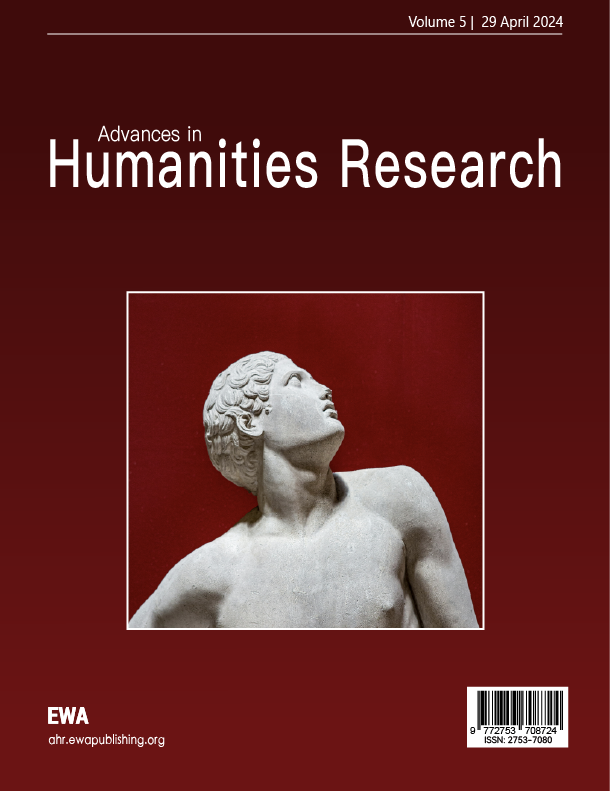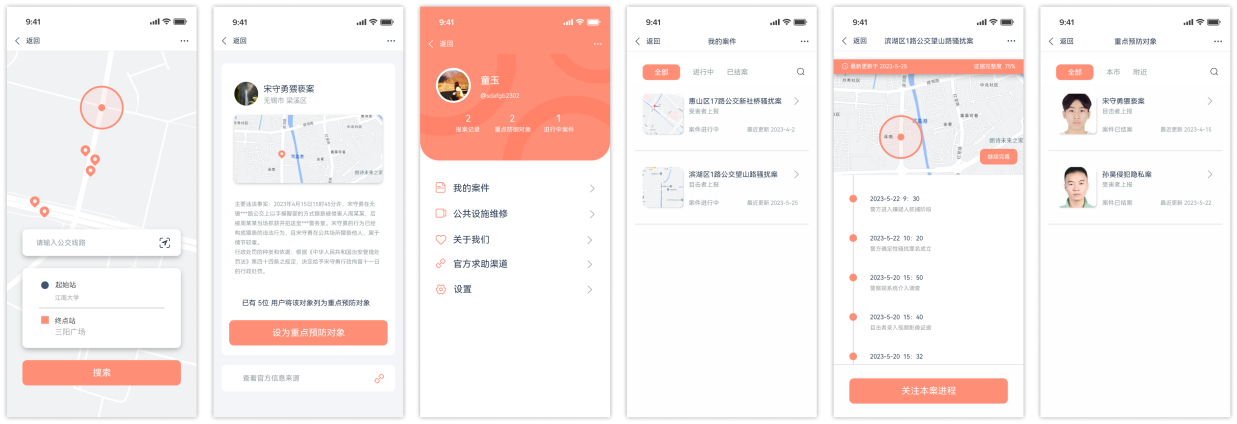1. Introduction
1.1. The importance of urbanization and public transportation systems
Public transportation systems play a crucial role in enhancing urban mobility and promoting social interaction in light of rapid urbanization and pervasive use of smart technologies. However, due to the closeness, high passenger mobility and difficult supervision in public transportation spaces, these systems have become hotspots for crimes like sexual harassment.
1.2. Current situation and impact of sexual harassment on buses
In China, female passengers are frequently the main victims of sexual harassment on buses, which is also a global issue that affects many countries. Large cities are the most impacted places, and the summertime and rush hours are particularly high-risk periods for such incidents. Sexual harassment is often covert with difficulties to obtain evidence, and the legal sanctions are relatively weak, hence this type of crime continues to exist [1]. Moreover, sexual harassment not only causes psychological trauma and affects interpersonal relationships for the victims but also lifts their sense of avoidance towards public places [2], and in turn, confines their employment opportunities, social engagement, and the overall stability of society [2, 3].
1.3. Research objectives and significance
This study aims to optimize the spatial layout and security systems of buses based on CPTED (Crime Prevention Through Environmental Design) theory, in order to minimize sexual harassment incidences by improving natural surveillance using environmental design approaches.
The primary objective of the research is to improve bus safety by minimizing opportunities for crimes through reasonable spatial design and technological interventions. Additionally, the study seeks to optimize the internal layout and service systems of buses, thereby enhancing female passengers’ overall experience during their commutes and safeguarding their security.
Furthermore, being applicable to the public transportation environment in China, this research also provides a theoretical foundation and practical guide for future development of public transportation safety systems.
2. Analysis of sexual harassment in public transportation
2.1. Research background of sexual harassment issues
Sexual harassment on buses is a global social issue, particularly prominent in densely populated urban areas [4]. Survey data reveals that 24% of female passengers have been sexually harassed on buses, with 84% of the victims being between the ages of 15 and 30. The incidence of sexual harassment is closely related to passenger density, and the crimes exhibit a bimodal distribution. Overcrowding at peak hours gives offenders more opportunities, while a lack of surveillance raises the danger.
Instances of sexual harassment often occur near the doors and around the handrails in the middle of the bus during busy times, with incidents of harassment directed at the buttocks being particularly common. In contrast, harassment in the seated areas is more frequently during off-peak hours, and it is more often hand based.
2.2. Factors influencing the occurrence of sexual harassment
Studies show that multiple factors contribute to the occurrence of sexual harassment, primarily including the following:
2.2.1. Passenger density
High passenger occupancy on buses during rush hours creates a congested atmosphere that offers covert opportunities for sexual harassment; thus, it is difficult for victims to recognize or resist the harassment. Despite that passenger flow is lower during off-peak hours, the sparse distribution of passengers on buses makes it easier for offenders to find opportunities to harass.
2.2.2. Gender ratio
Survey data indicates that the incidence of sexual harassment increases with the number of male passengers in the vicinity. A higher proportion of male passengers can make offenders feel more secure and less likely to be reported.
2.2.3. Cabin environment
Environmental factors such as lighting and noise within the bus can also influence the occurrence of sexual harassment. According to the research, 70% of victims reported that the cabin was noisy when they were harassed, while 40% stated that the lighting was normal. This suggests that environmental factors are not the sole determinants, however, a noisy atmosphere may make nearby passengers less vigilant, thereby increasing the possibility for harassment to occur.
2.2.4. Sociocultural factors
Sociocultural factors including gender inequality and women’s disadvantaged social position are considered as underlying causes of sexual harassment. Female victims often choose to remain silent because of societal stereotypes about women and their high tolerance for sexual harassment incidents, hence the similar cases continue to occur due to such cultural acceptance and the absence of social condemnation.
2.3. The unique nature of bus spaces
Buses are a confined public space with the following special features:
2.3.1. Limited space
The space inside a bus is confined, particularly during peak hours, when physical contact between passengers is inevitable, fostering an atmosphere that is conducive to sexual harassment. Victims find it challenging to distance themselves from the offenders throughout the trip because buses usually only have one compartment.
2.3.2. Blind spots
The seating arrangement and handrail design inside buses may result in areas that become blind spots, particularly in crowded situations, in which natural surveillance becomes nearly ineffective, facilitating the concealment of criminal activities.
2.3.3. High passenger mobility
A bus is a highly mobile space, allowing perpetrators to quickly get on and off, making it challenging to track them after they escape, which increases the difficulty for victims in seeking assistance or pursuing legal action.
2.4. Passenger density and time factors (peak hours vs. off-peak hours)
2.4.1. Peak hours
Sexual harassment often takes place during peak hours in the congested space in the middle of the bus and close to the doors, as the large number of passengers results in frequent physical contact between commuters. Victims in such dense crowd are often unable to immediately notice or resist the harassment, and the other passengers’ distracted attention makes it difficult for them to offer effective assistance. The crowded conditions create an environment where offenders can more easily engage in inappropriate behavior without being detected or confronted.
2.4.2. Off-peak hours
Sexual harassment usually occurs in the seating areas during off-peak hours when there are fewer passengers. Perpetrators can more easily target victims since passengers are more sparsely distributed, and the relative isolation of the victim makes it difficult for them to receive support from surrounding passengers. In these less crowded conditions, offenders may feel emboldened by the lower chance of immediate intervention or detection.
2.5. Ineffective law enforcement and weak awareness of women's rights
Despite the frequent occurrence of sexual harassment, there are still significant issues with law enforcement and awareness of women's rights, which hinder the reduction of the incidence of sexual harassment.
2.5.1. Ineffective law enforcement
Survey data reveals that the main reasons why over half of victims decide not to assert their rights include insufficient evidence, distrust in the judicial system, and fear of retaliation. Additionally, the problem is further exacerbated by the lack of effective reporting systems on buses, which make it more difficult for victims to receive timely assistance. This deficiency in law enforcement and support mechanisms discourages victims from taking legal action and allows perpetrators to harass with impunity.
2.5.2. Weak awareness of protecting women's rights
Sexual harassment is widely tolerated in society, and victims often decide to keep quiet out of fear of shame or blame. Survey data shows that 58% of victims believe there is insufficient evidence to prove the harassment, 38% do not trust the judicial system, and 26% face obstacles when seeking help from bus security personnel. In addition to discouraging victims from seeking justice, the lack of awareness and support for women's rights perpetuates the cycle of silence and impunity.
3. Overview of natural surveillance theory
3.1. Basic concepts of natural surveillance theory
Natural Surveillance, which seeks to decrease crime opportunities by optimizing spatial design to improve visibility and observability in the environment, is one of the core concepts of Crime Prevention Through Environmental Design (CPTED). The fundamental principle of natural surveillance to deter crimes through increasing the number of watchers and broadening their vision scope, which can make potential offenders feel a higher risk of being watched. In contrast to typical methods to keep security like cameras or guards, natural surveillance emphasizes enhancing the ability of legitimate users to monitor a space through design measures, such as adjusting spatial layout, increasing lighting, and minimizing blind spots [5]. Figure 3 illustrates the seven concepts of CPTED and its dynamic integration model [6].

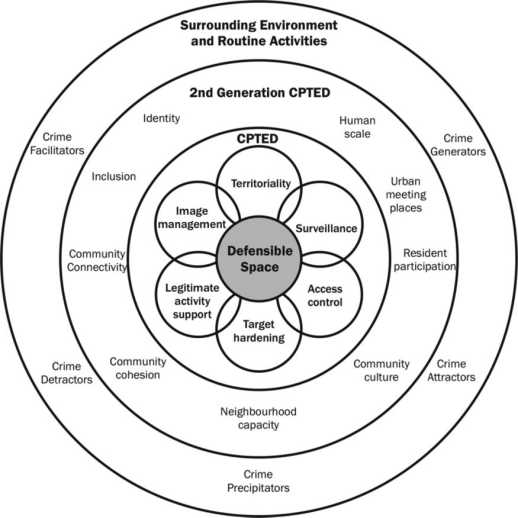
(a)The seven principles of CPTED (b)The dynamic integration model of CPTED
Figure 1. System construction of CPTED theory
3.2. Application of natural surveillance in crime prevention
The following aspects demonstrate how natural surveillance theory is applied in crime prevention:
3.2.1. Enhancing visibility
Optimizing spatial layout and reducing blind spots might make potential offenders feel more at risk of being watched.
3.2.2. Guiding foot traffic
Spatial design is adopted to direct people's sightlines and movement patterns, increasing surveillance of key areas.
3.2.3. Enhancing users’ sense of security
Increasing natural surveillance helps legitimate users feel more secure and reduce their fear of crime.
3.2.4. Deterring crime
By increasing the number of and expanding the scope of observers, criminal acts can be suppressed since potential offenders perceive a higher probability of being reported or apprehended [5].
3.3. Case analysis of current public space crime prevention design
Natural surveillance theory is typically applied in the following approaches in current public space crime prevention design cases:
3.3.1. Optimizing lighting
Illumination is increased in public spaces to reduce dark corners and improve visibility.
3.3.2. Reducing obstacles
Objects that obstruct sightlines are removed or minimized to increase the openness of the space.
3.3.3. Guiding sightlines
Spatial design is used to direct people's sightlines toward key areas, such as entrances, exits, and aisles.
3.3.4. Increasing surveillance points
Features such as windows and transparent partitions are added to make activities within the space more observable [7].
4. Proposal for bus anti-harassment design
Based on the theory of natural surveillance, the proposal for bus anti-harassment design primarily focuses on optimizing three modules: spatial layout design, product and service systems, and software service support. As shown in figure 1-4.

Figure 2. Module functional architecture
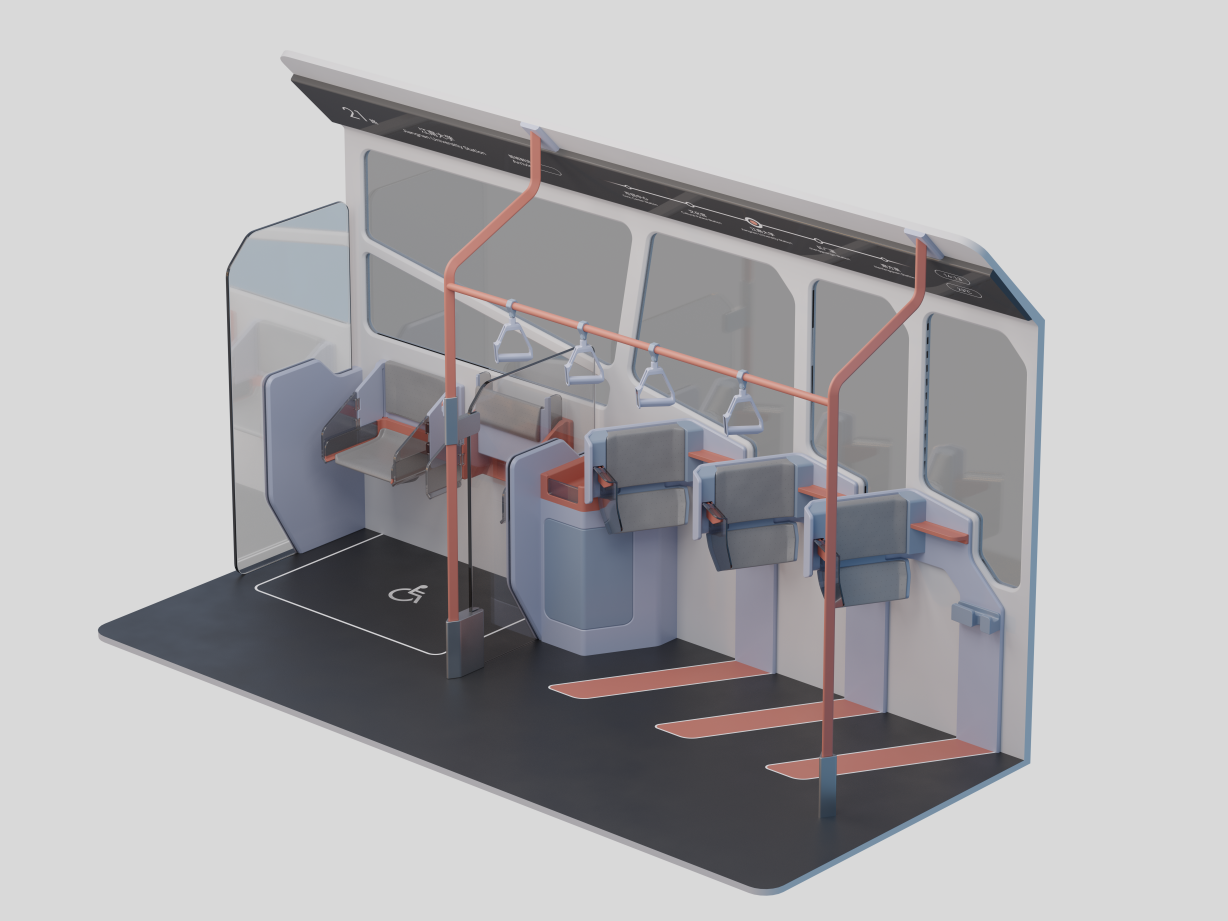
Figure 3. Overall view of the public bus sexual harassment prevention product system
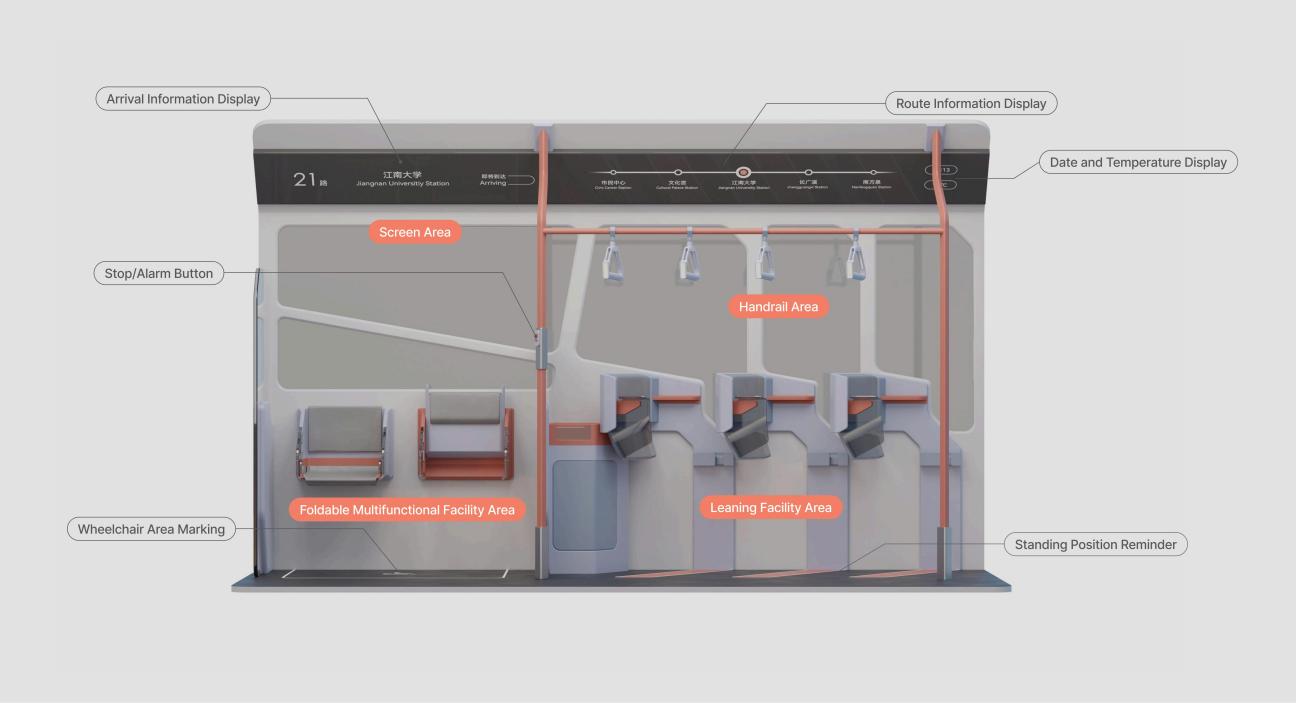
Figure 4. Product layout
4.1. Spatial layout design module
Optimization of seat and handrail arrangement: By adjusting the arrangement of seats and handrails, the design increases visual crossovers between passengers and reduces blind spots. For example, placing seats at a 45° angle can avoid passengers’ discomfort caused by directly facing each other, while enhancing natural surveillance. As shown in figure 5-8.

Figure 5. Current public bus natural surveillance layout

Figure 6. Natural surveillance visualization calculation(current public bus)

Figure 7. Optimized spatial arrangement for natural surveillance layout

Figure 8. Natural surveillance visualization calculation (optimized spatial arrangement)
4.1.1. Passenger orientation guidance design
Seating and standing are designed to direct passengers' posture and orientation, guiding their sightlines toward key areas of the bus, such as doors and aisles, in order to improve surveillance of potential criminal activities. As shown in figure 9-11.

Figure 9. Sight guidance diagram for product area

Figure 10. Standing direction control:angle-limited handrail

Figure 11. Seated position direction control: seat position angle layout
4.1.2. Increasing visibility of key areas (e.g. doors)
The chance of criminal activities is decreased by adding transparent partitions, mirrors, and other design elements to make key areas such as bus doors more visible increase the visibility of key areas such as bus doors. As shown in figure 12-14.

Figure 12. Key area

Figure 13. Transparent partition: visibility increase
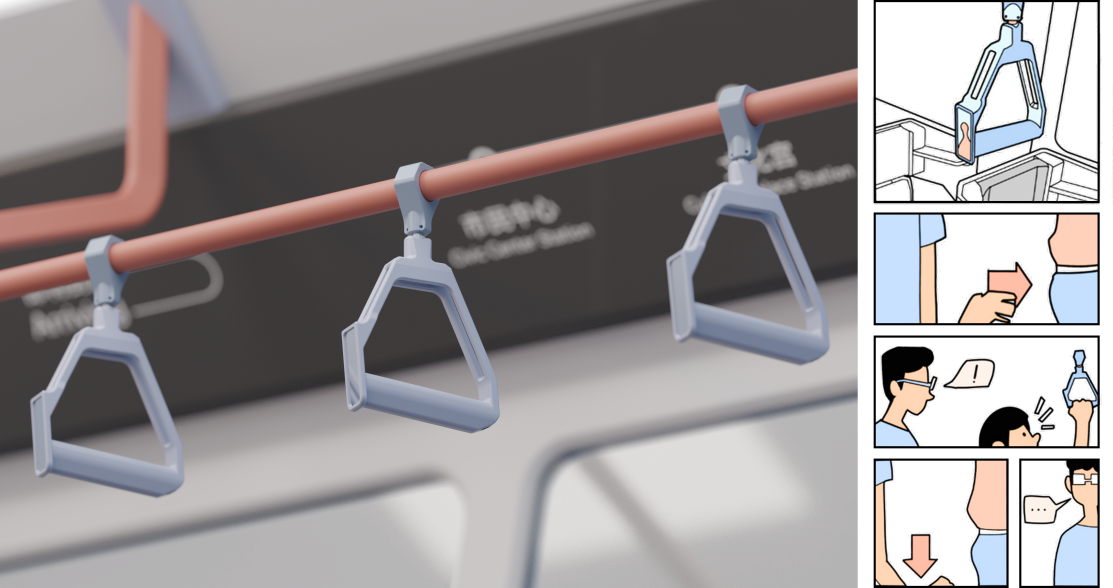
Figure 14. Reflective mirror: reduce blind spots
4.2. Product and service system module
4.2.1. Physical protection devices
Designing foldable and supportive multifunctional facilities that protect waist and hip by covering vulnerable areas can expand the space for defense, which increases passengers' sense of security. As shown in figure 15-18.
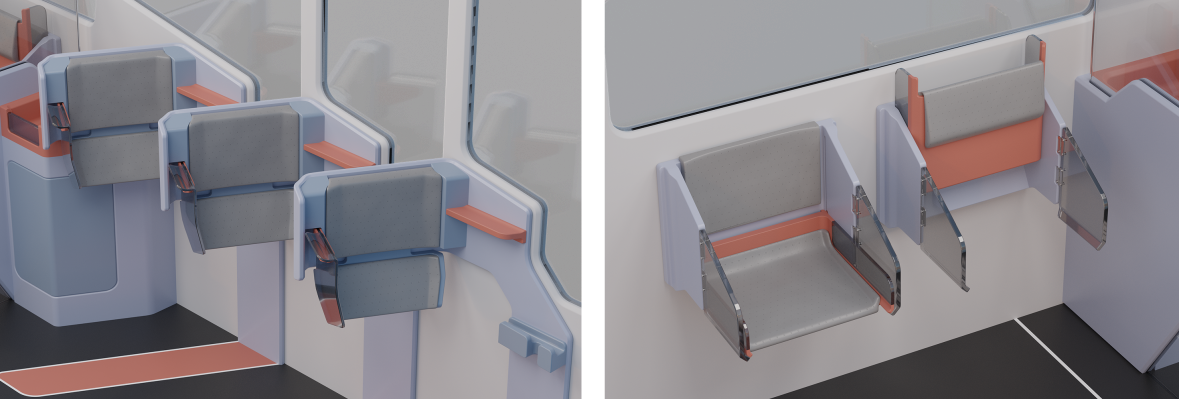
Figure 15. Leaning hardware & folding hardware render

Figure 16. Leaning hardware & folding hardware exploded view
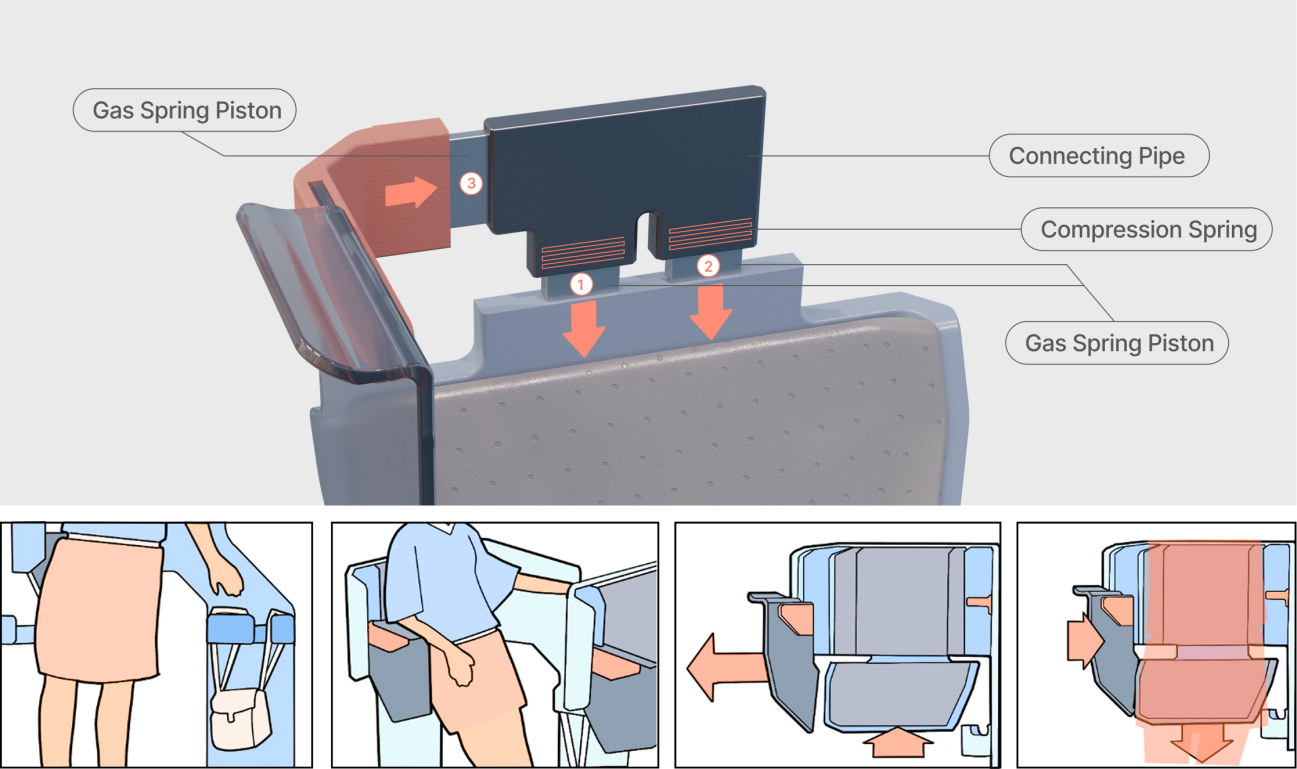
Figure 17. Leaning hardware principle and usage introduction

Figure 18. Six views and dimensions
4.2.2. Surveillance and alarm system optimization
Installing alarm buttons and surveillance equipment inside the bus allows passengers to promptly report harassment and obtain aid when needed. As shown in figure 19-20.
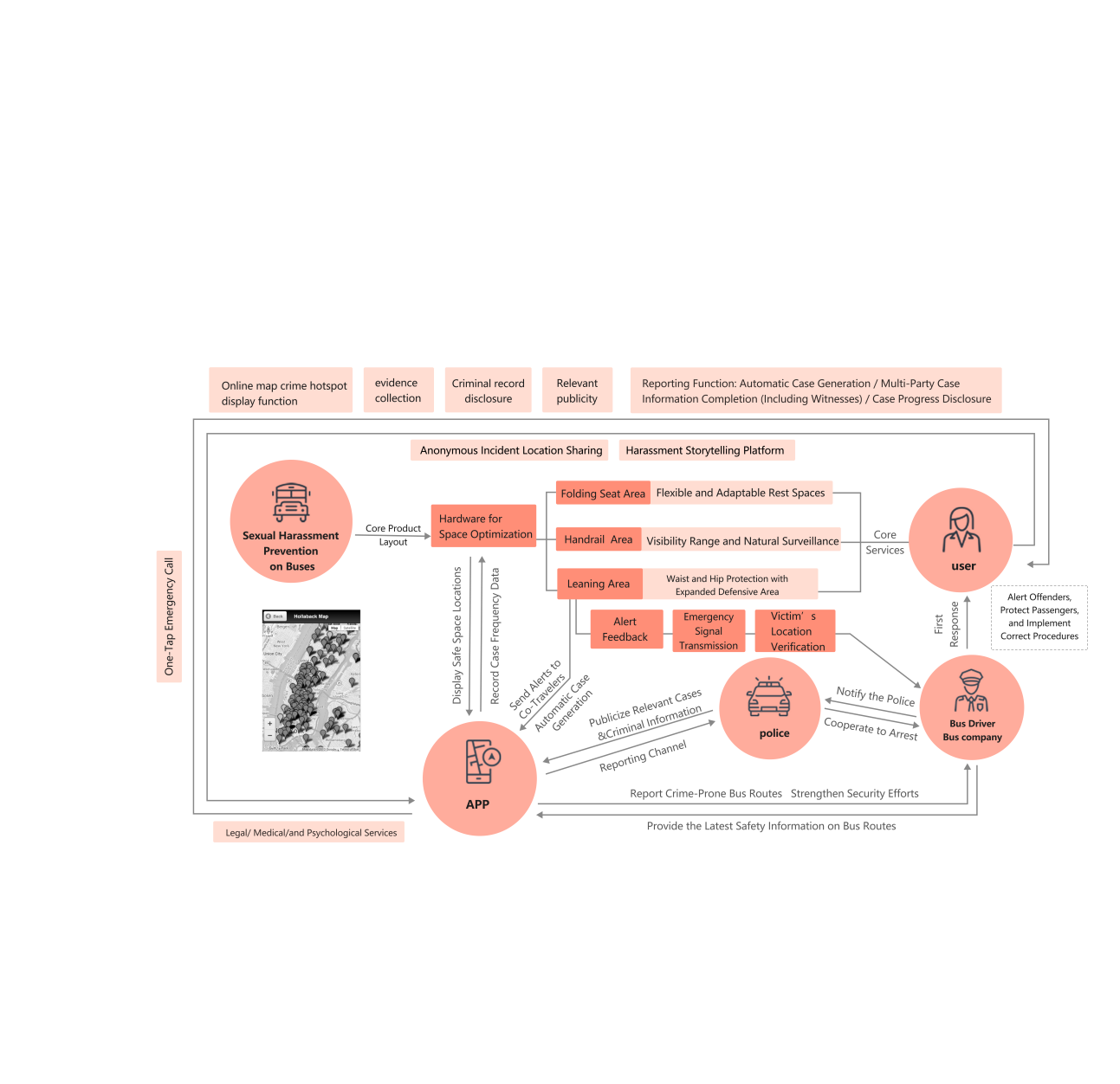
Figure 19. Police-community linked alarm system
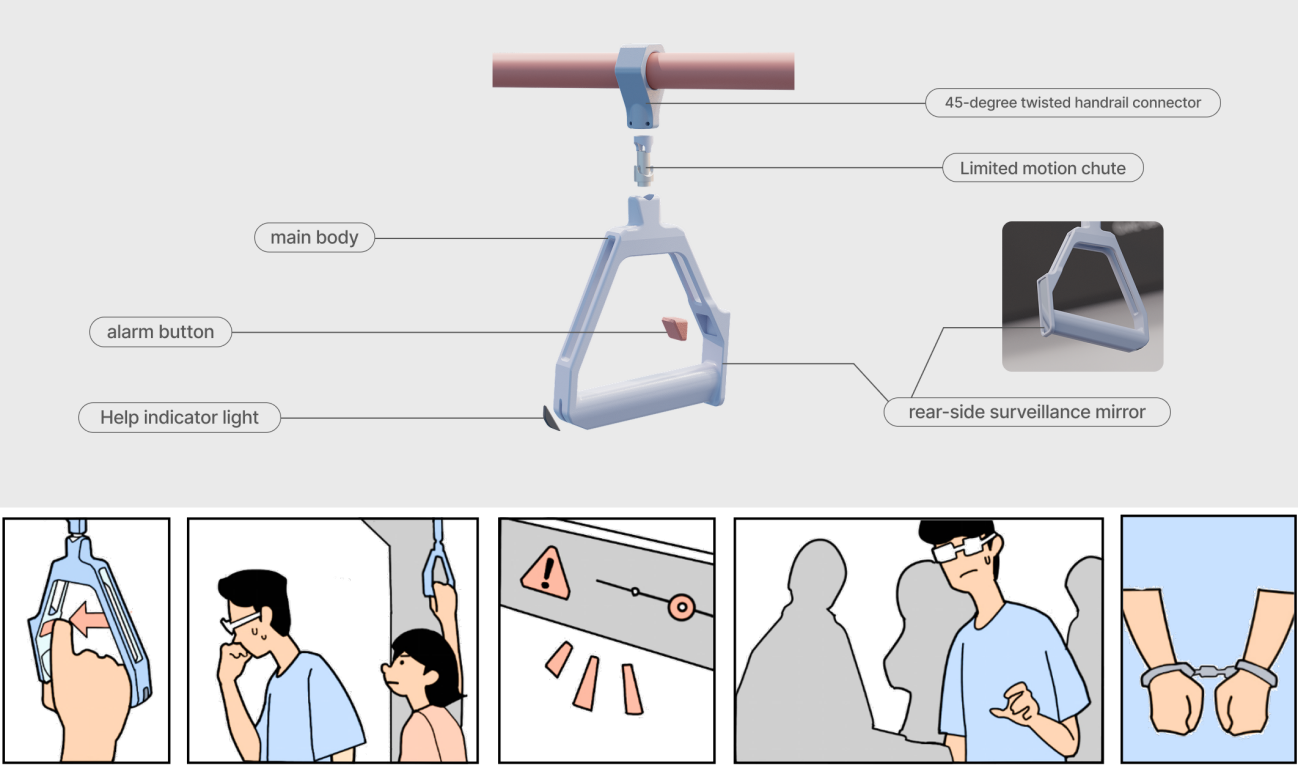
Figure 20. Handrail alarm button & cabin monitoring alarm
4.2.3. In-vehicle information guidance system
In-vehicle display screens, or mobile apps are employed to provide passengers with information on safety advice and crime prevention, enhancing their awareness of security. As shown in figure 21.

Figure 21. Information guidance system
4.3. Software service support module
4.3.1. Passenger assistance and reporting system
Passengers can use the app platform to report sexual harassment instantly and receive assistance from nearby passengers. The app also provides features such as incident reporting and information disclosure to make passenger feel more secure. As shown in figure 22-23.
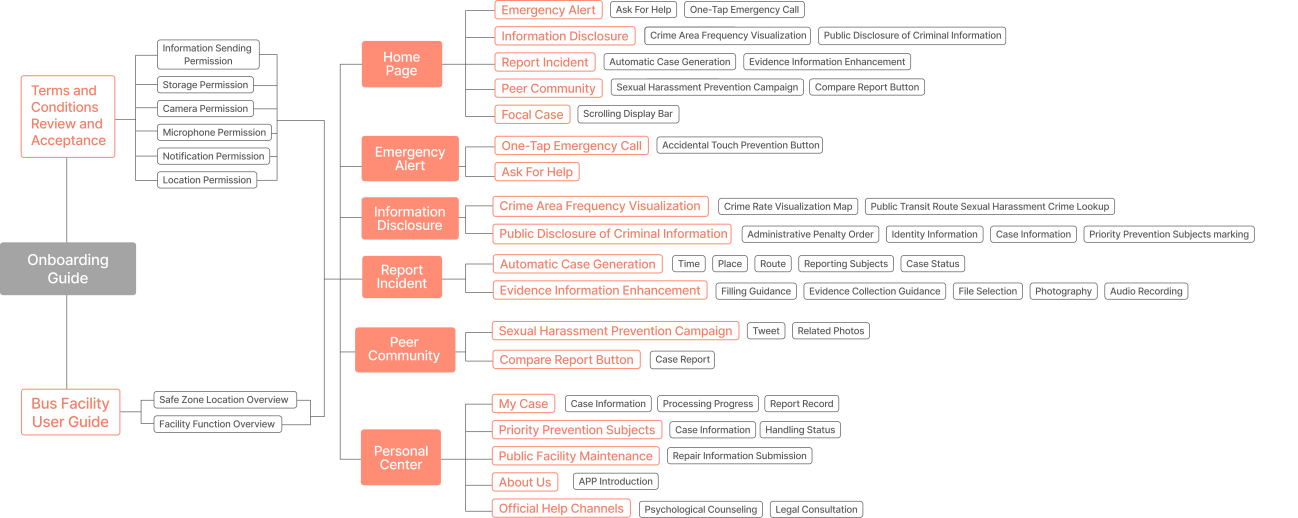
Figure 22. App information architecture
|
(a) |
|
(b) |
|
(c) |
Figure 23. App high-fidelity display
4.3.2. Data analysis and dynamic adjustment plan
By collecting and analyzing data on sexual harassment incidents, the bus layout and safety measures can be dynamically adjusted to optimize the anti-harassment strategy.
5. Innovation and practical application
5.1. Innovative features of the design proposal
5.1.1. Innovative application of natural surveillance theory
The design proposal optimizes the bus interior layout by introducing natural surveillance theory to improve visibility and monitoring capabilities within the bus. For example, arranging seats and handrails can increase the visual intersections between passengers and reduce blind spots, which may deter potential sexual harassment.
5.1.2. Integration of visual aesthetics and high-quality spatial design
The design proposal focuses on visual appeal and high-quality spatial design in addition to functionality. Neutral colors and shapes are used to ensure that it is non-invasive while improving passengers’ comfort and security. For example, the polarized film of the foldable multifunctional facilities provides protection while maintaining visual transparency within the bus.
5.1.3. Application of gas spring technology and polarized film
Gas Spring and polarized film technologies are creatively incorporated in the design proposal. Gas spring technology applied in the supportive facilities achieves an automatic reset function through pressure linkage to improve the functionality and comfort of the facilities. Polarized film technology is applied to the foldable multifunctional facilities, adjusting light permeability to protect privacy while maintaining visibility inside the bus.
5.2. Feasibility and promotion value of the proposal
5.2.1. Feasibility analysis
The design proposal is based on current well-developed and easily implemented gas spring and polarized film technologies. Prototype test and user feedback show that the design has demonstrated excellent performance in terms of functionality and user experience, making it highly feasible.
5.2.2. Promotion value
This proposal is not only applicable to buses but can also be extended to other means of public transportation and public spaces, such as subways, shopping malls, etc. It has extensive marketing potential due to its modular design and adaptable functionality, which can meet the specific needs of different spaces.
5.3. Recommendations on future implementation and optimization of bus systems
5.3.1. Recommendations on implementation
First of all, a pilot program should be conducted on selected buses to collect user feedback and make necessary optimizations and gradually expand the implementation across the entire bus network. Secondly, both bus drivers and passengers should be instructed on how to properly use the new facilities and safety precautions to ensure the smooth implementation of the plan. Finally, a regular monitoring and maintenance system should be established to ensure the long-term effective operation of the facilities.
5.3.2. Recommendations on optimization
Firstly, a user feedback system should be set up to regularly collect passengers' opinions and suggestions, which ensures ongoing optimization of the design. In line with future technological advancements, gas spring and polarized film technologies can be continuously upgraded to enhance the intelligence and automation level of the facilities.
5.4. Applicability expansion to other public spaces
5.4.1. Subway
In subway, similar natural surveillance designs can be applied by optimizing the arrangement of seats and handrails to improve inside visibility, which will lessen the chances for crimes by reducing blind spots and ensuring clear sightlines[8, 9].
5.4.2. Shopping malls
Polarized film technology can be applied in public rest areas and corridors of shopping malls to protect privacy while maintaining the openness of the space, which will increase customers' sense of security by protecting their privacy without compromising visibility and surveillance within the space.
5.4.3. Other means of public transportation
Similar design solutions can be used at airports, trains, and other public spaces to improve passengers’ comfort and make them feel more secure, while reducing the occurrence of sexual harassment incidents [8].
6. Conclusion and outlook
In this study, a bus anti-harassment design is established based on spatial layout and product service systems by innovatively combining natural surveillance theory with gas spring and polarized film technologies. In addition to improving passengers’ comfort and safety on buses, the design demonstrates strong feasibility and promotion potential. This approach can be extended to other public spaces with progress implementation and optimization, providing a safe and comfortable travel environment for more passengers and contributing favorably to the protection of women.
References
[1]. Li, L. X., & Zheng, Y. Q. (2020). Women's safety and public space design. Urban Architecture, 17(22), 158–161.
[2]. Bai, R. (2009). Space, body, and the neglected female [Master's thesis]. Minzu University of China.
[3]. Cozens, P. M., Saville, G., & Hillier, D. (2005). Crime prevention through environmental design (CPTED): A review and modern bibliography. Property Management, 23(5), 328–356.
[4]. Cozens, P., & Love, T. (2015). A review and current status of crime prevention through environmental design (CPTED). Journal of Planning Literature, 30(4), 393–412.
[5]. Dunckel-Graglia, A. (2013). Women-only transportation: How “pink” public transportation changes public perception of women’s mobility. Journal of Public Transportation, 16(2), 85–105.
[6]. Gekoski, A., Gray, J. M., Horvath, M. A. H., Edwards, S., Emirali, A., Adler, J, R. (2015). What works in reducing sexual harassment and sexual offences on public transport nationally and internationally: A rapid evidence assessment. [Unpublished manuscript].
[7]. Hoor-Ul-Ain, S. (2020). Public sexual harassment mayhem on public transport in megacities - Karachi and London: A comparative review. Aggression and Violent Behavior, 52, Article 101420.
[8]. He, Y. (2021). Optimization strategies for public space in subway stations from a female perspective: A case study of Chengdu. Urban Architecture, 18(3), 95–98.
[9]. Margaret Brown. (2021). Sexual Harassment and Assault in Government Agencies. [EB/OL]. ISBN: 978-1-53619-576-7
Cite this article
Li,X. (2025). Bus anti-harassment design based on natural surveillance theory innovative exploration of spatial layout and product service system. Advances in Humanities Research,12(2),39-53.
Data availability
The datasets used and/or analyzed during the current study will be available from the authors upon reasonable request.
Disclaimer/Publisher's Note
The statements, opinions and data contained in all publications are solely those of the individual author(s) and contributor(s) and not of EWA Publishing and/or the editor(s). EWA Publishing and/or the editor(s) disclaim responsibility for any injury to people or property resulting from any ideas, methods, instructions or products referred to in the content.
About volume
Journal:Advances in Humanities Research
© 2024 by the author(s). Licensee EWA Publishing, Oxford, UK. This article is an open access article distributed under the terms and
conditions of the Creative Commons Attribution (CC BY) license. Authors who
publish this series agree to the following terms:
1. Authors retain copyright and grant the series right of first publication with the work simultaneously licensed under a Creative Commons
Attribution License that allows others to share the work with an acknowledgment of the work's authorship and initial publication in this
series.
2. Authors are able to enter into separate, additional contractual arrangements for the non-exclusive distribution of the series's published
version of the work (e.g., post it to an institutional repository or publish it in a book), with an acknowledgment of its initial
publication in this series.
3. Authors are permitted and encouraged to post their work online (e.g., in institutional repositories or on their website) prior to and
during the submission process, as it can lead to productive exchanges, as well as earlier and greater citation of published work (See
Open access policy for details).
References
[1]. Li, L. X., & Zheng, Y. Q. (2020). Women's safety and public space design. Urban Architecture, 17(22), 158–161.
[2]. Bai, R. (2009). Space, body, and the neglected female [Master's thesis]. Minzu University of China.
[3]. Cozens, P. M., Saville, G., & Hillier, D. (2005). Crime prevention through environmental design (CPTED): A review and modern bibliography. Property Management, 23(5), 328–356.
[4]. Cozens, P., & Love, T. (2015). A review and current status of crime prevention through environmental design (CPTED). Journal of Planning Literature, 30(4), 393–412.
[5]. Dunckel-Graglia, A. (2013). Women-only transportation: How “pink” public transportation changes public perception of women’s mobility. Journal of Public Transportation, 16(2), 85–105.
[6]. Gekoski, A., Gray, J. M., Horvath, M. A. H., Edwards, S., Emirali, A., Adler, J, R. (2015). What works in reducing sexual harassment and sexual offences on public transport nationally and internationally: A rapid evidence assessment. [Unpublished manuscript].
[7]. Hoor-Ul-Ain, S. (2020). Public sexual harassment mayhem on public transport in megacities - Karachi and London: A comparative review. Aggression and Violent Behavior, 52, Article 101420.
[8]. He, Y. (2021). Optimization strategies for public space in subway stations from a female perspective: A case study of Chengdu. Urban Architecture, 18(3), 95–98.
[9]. Margaret Brown. (2021). Sexual Harassment and Assault in Government Agencies. [EB/OL]. ISBN: 978-1-53619-576-7





